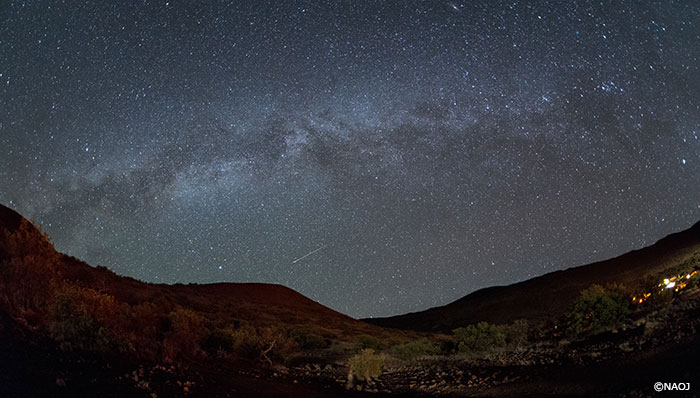Mauna Kea, Summer's Contest - The Milky Way Verses the Perseid Meteor Shower
Night Scape Photograph・

| Date | 2:55 am August 12, 2013 (Hawaii Standard Time) |
|---|---|
| Camera | Nikon D600 |
| Lens | 15 mm F2.8 EX DG DIAGONAL FISHEYE |
| Exposure | f/2.8, 30 seconds, ISO6400 |
| Location | Onizuka Center for International Astronomy Visitor Information Station on Mauna Kea , Hawai'i Island |
| Photographer | Shogo Nagayama |
| Copyright | National Astronomical Observatory of Japan |
Download
- Middle resolution (940 x 535, 515KB)
- High resolution (2000 x 1138, 2.2MB)
- Maximum resolution (2976 x 3422, 19.1MB)
Related Link
NAOJ is conducting a campaign “Summer Nights: Let's Count Shooting Stars, 2014” to coincide with expected Perseid Meteor Shower activity. Moonlight will have a large impact on the 2014 Perseid Meteor Shower. But please participate in this campaign and look up at the night sky during this opportunity to easily see meteors.
Far from the city lights, on a dark moonless night, the Milky Way stretches out faintly in the summer night sky. This picture taken from Mauna Kea on Hawai'i Island reveals the splendor of the delicately intertwined countless faint stars and the dark nebulae of the Milky Way floating in the northern sky. By luck in this picture, a shooting star also flew into the center of the frame from the northeastern sky. This day was the peak of the Perseid Meteor Shower, one of the three biggest meteor showers. In this instant, the wonders of the summer sky were competing against each other.
The Northern Starry Sky as seen from Hawai'i
This picture captures the northern sky from Mauna Kea. The bright star a little to the right of center and just above the ridge is the North Star. You can make out the Great Summer Triangle: the conspicuously brightly shining star above the ridge line to the left of center is Vega in the constellation Lyra; in the left side of the image, on the opposite side of the Milky Way is Altair in the constellation Aquila; near the center of the image, within the Milky Way, is Deneb in the constellation Cygnus.
The Milky Way in Summer
The Milky Way in all its glory cutting across the sky. The oldest remaining confirmed report of the Milky Way of being comprised of countless stars comes from Galileo Galilei. If you look closely, you can see dark areas with few stars stretching out like a flowing river. These are expanses of dark nebulae composed of solid particles floating in space (interstellar dust) which absorb starlight.
The Perseid Meteor Shower
Right above the North Star, the constellation Cassiopeia can be seen inside the Milky Way. In the area immediately to the East (right) the constellation Perseus falls into line. Centered around August 12, meteors can be seen streaking in all directions from a point of origin in this area. Near the maximum of the Perseid Meteor Shower many shooting stars appear, so it is famous as an easy meteor shower to observe.
Author: Seiichiro Naito (NAOJ Public Relations Center)